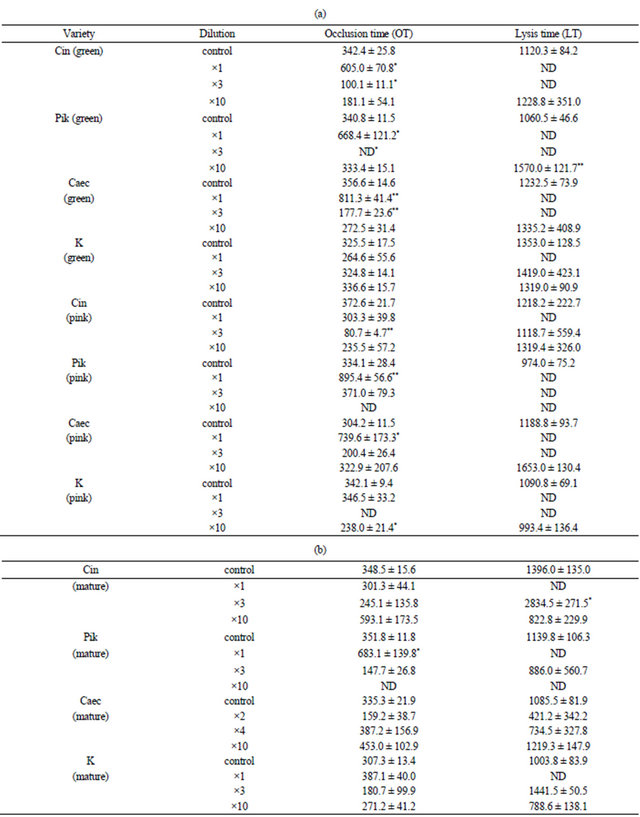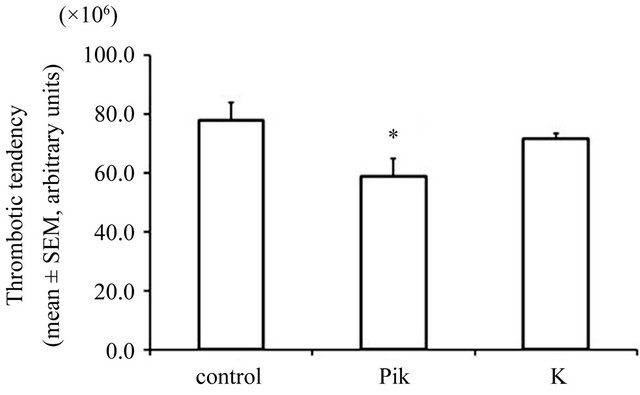The antithrombotic activity of mini-type tomatoes is dependent on the particular variety and the stage of harvest. Lycopene content does not contribute to antithrombotic activity ()
1. INTRODUCTION
“Lifestyle-related atherothrombotic diseases” represent the major cause of death in many developed countries and the prevention of cardiovascular diseases of this nature is widely regarded as an important and urgent social task. We have focused on studies designed to identify fruits and vegetables with antithrombotic activity with the potential to prevent disorders of this nature. We have devised laboratory tests to classify a number of antithrombotic fruit and vegetable varieties [1-8], and the present study extends this data to include different varieties of tomato.
Platelets play a pivotal role in arterial thrombotic diseases including myocardial infarction and stroke. Platelet-function in vitro is commonly assessed using platelet aggregometry, which measures platelet aggregation induced by various chemical agonists in vitro. In clinical practice, however, tests using native, non-anticoagulated blood in the presence of physiological shear force are likely to be much more relevant to the in vivo environment than those using anticoagulated blood and chemical platelet agonists. The present study was undertaken, therefore, as part of a series of investigations to examine antithrombotic fruits and vegetables with a shear-induced platelet function in vitro test using non-anticoagulated (native) blood together with a helium-neon laser induced in vivo thrombosis method [9-14]. Concentrations of the antioxidant, lycopene, were also examined.
We have demonstrated the potential of mini-type varieties of tomato, and have shown that antithrombotic properties may be dependent on the particular variety and stage of maturity. Our results indicated that these antithrombotic properties were not related to the concentration of the antioxidant, lycopene [15].
2. MATERIALS AND METHODS
2.1. Animals
Male Wistar 13-week-old ST rats (Japan SLC Co. Ltd., Hamamatsu, Japan) and 10-week-old male C57BL/6 mice (Japan SLC Co. Ltd., Hamamatsu, Japan) were purchased one week before the scheduled experiments. Animals were maintained in compliance with the “Guiding Principles for the Care and Use of Animals in the field of Physiological Sciences”, published by Physiological Society of Japan. The protocol was approved by the Animal Experiment Committee of Kobe Gakuin University.
2.2. Tomatoes
Three kinds of mini-type tomato varieties coded as “Cin”, “Pik” and “Caec” and medium-type variety, coded “K”, were harvested at different stages of maturity (green, pink and mature) from the same field in Kobe City, Japan.
2.3. Preparation of Tomato Filtrate
Several washed tomatoes from each variety were crushed, with skin, blended and the juice obtained by centrifugation at 3000 rpm for 15 min at 4˚C. The supernatant was filtered (pore size 0.5 μm; Schleicher & Schuell GmbH., Dassel, Germany) and the clear filtrates were stored at –80˚C until use.
2.4. In Vitro Assessment of Platelet Activity and Endogenous Thrombolytic Activity by the Global Thrombosis Test (GTT)
The GTT test (Montrose Diagnostics Ltd., UK) has been described in detail earlier [10-13,16,17]. In brief, native blood is passed through four narrow channels where platelets are activated by the high shear stress (145 dyne/cm2). Down-stream from this point, the flow is slow and turbulent, and platelets aggregate and form thrombin. Consequently, fibrin-stabilized platelet aggregates (thrombi) cause occlusion and stop blood flow. The instrument detects the time interval (d, sec) between consecutive blood drops. At the start, blood flow is rapid and hence (d) is small. Subsequently, the flow rate decreases and hence (d) increases. When the actual (d) exceeds 15 seconds (before the flow is completely arrested), the instrument displays “Occlusion Time (OT, sec)”. Subsequently, flow is restored due to thrombolysis, and is indicated by the detection of the first blood drop (Lysis Time (LT), sec).
In the present investigations, blood was withdrawn from the abdominal aorta of rats 30 minutes after Nembutal anaesthesia (60 mg/kg, im) and diluted with saline in 1:1 ratio. 0.4 ml tomato filtrate or 0.4 ml saline (control) were added to 3.6 ml of the diluted blood, mixed and transferred to the GTT test tube within 15 sec after withdrawal of blood. Four blood containing various concentrations of tomato filtrates and control were assessed in four channels simultaneously and the tests were repeated six times (n = 6) for each sample.
2.5. Helium-Neon (He-Ne) Laser-Induced Thrombosis in Vivo Model in Mice
The Helium-Neon laser-induced thrombosis method has been previously described in detail [14]. In brief, the left femoral artery of an anaesthetized mouse was exposed and Evans blue dye was injected intravenously. The center of the carotid artery was irradiated with the laser beam, and the formation of thrombi at the site of irradiation was monitored and recorded on videotape. Calculation of thrombus size has been described earlier [14]. In outline, images of thrombus formation were computer-analysed at intervals of ten seconds. The area of thrombus was delineated and the mass of thrombus calculated by multiplying gray scale and area using Image J software (Image Processing and Analysis Java version 1.30, National Institutes of Health, Maryland, USA). Thrombotic status was expressed as the total sum of thrombus mass after the first 10 minutes of irradiation.
2.6. Antithrombotic Effect of Tomato Filtrates after Oral Administration
Filtrates and controls (distilled water) (7.7 ml/kg × 2) were orally administered to the animals through a gastric tube. A second dose using the same volume of filtrate or water was given 30 min later. Mice were anaesthetized and the laser-induced thrombosis experiments commenced 90 min after the second oral treatment. The antithrombotic or prothrombotic effects were assessed by measuring the total thrombus size. Antithrombotic activity was related to smaller thrombus formation.
2.7. Lycopene Content
Lycopene content of tomato filtrates was commercially measured by HPLC (Japan Food Research Laboratories, Tokyo, Japan).
2.8. Statistical Analysis
OT and LT were analyzed by repeated ANOVA, followed by post hoc (Dunnett). Thrombus size in the laser-induced experiments was analysed by ANOVA and followed by post hoc (Dunnett). Values were expressed as means ± SEM. P < 0.05 was considered as statistically significant. Analysis was performed by statistical package software (Unistat Light 5.6, Unistat Ltd., London, UK).
3. RESULTS
3.1. Effect of Tomato Variety Filtrates and Harvest Phase on Platelet Activity and Endogenous Thrombolytic Activity in Vitro
The results are shown in Table 1. At the green stage, all varieties except “K” significantly inhibited platelet activity (OT). At the pink stage, “Pik” and “Caec” inhibited OT but “Cin” and “K” did not. At the mature stage, only “Pik” inhibited this measurement. These results demonstrated that inhibition of OT was dependent on the particular variety and stage of maturity of the different tomatoes.
The effects on thrombolysis were difficult to determine because both inhibition of OT and enhanced thrombolysis caused less haemostatic plug mass formation.
3.2. Antithrombotic Effects of Tomatoes at the Mature Stage Assessed by the He-Ne Laser-Induced Thrombosis Test
The antithrombotic activity of the different tomato varieties was assessed by laser-induced thrombosis in vivo (Figure 1). The variety “Pik” demonstrated antithrombotic activity. In contrast, the variety “K” showed no antithrombotic activity. The results indicated that platelet reactivity in vivo, assessed by the He-Ne laser-induced platelet-rich thrombosis test, was consistent with that observed by the shear-induced platelet test in vitro.
3.3. Lycopene Concentration in Various Tomato Varieties
Lycopene, which appears to be the most readily available carotenoid in tomatoes, was measured in the various varieties at the early and full mature stages. The results are shown in Table 2. Little lycopene was detected in any of the mini and medium-type varieties, although full-size market tomatoes had significant amounts. The results indicate that antithrombotic activity was not related to lycopene in the mini-type tomatoes used in the present experiments.
3.4. Maturation Phase and Antiplatelet Thrombotic Activity Assesses by Global Thrombosis Test (GTT)
Results are shown in Figure 2. Antiplatelet activity was maximum at the early green phase and decreased with maturation. With the “Pik” variety, antiplatelet activity remained consistent from the green stage to the mature stage. In contrast, antiplatelet activity decreased with maturation in “Cin” and “Caec” varieties. Antiplatelet activity was not observed at any stage with the “K” variety.
4. DISCUSSION
In our on-going series of investigations on the role of nutrition in the pathogenesis of arterial thrombotic diseases, we have targeted especially dietary fruits and vegetables with antithrombotic activity. In addition, we have utilized novel, shear-induced platelet-rich thrombosis tests using non-anticoagulated blood rather than conventional tests dependent on agonist-induced platelet aggregation and thrombotic markers using anticoagulated blood. The innovative shear-induced platelet reactivity test Global Thrombosis Test (GTT) also enabled the concurrent assessment of endogenous thrombolytic activity. Tests of this nature have facilitated the classification of different varieties of mulberry, carrot, potato and onion according to antithrombotic activity [4-6,8]. Furthermore, we have confirmed that systemic antithrombotic activity depends on a balance between platelet reactivity and thrombolytic activity [4-6,8]. Our findings offer the challenging possibility that regular daily diets containing particular antithrombotic fruits and vegetables could help to prevent arterial thrombotic diseases.
In our thrombosis/thrombolysis animal model, the GTT is designed to measure shear-induced platelet reactivity in vitro, and the He-Ne laser-induced thrombosis technique is used to assess hemostasis in vivo. In the present study, the concentration of the antioxidant lycopene was also measured in three mini-type tomato varieties, coded “Cin”, “Pik” and “Caec”, and one mediumtype variety, coded “K”. In our previous studies, we tested antithrombotic activity using Haemostatometry, an early test of shear-induced platelet function. We demonstrated that tomato varieties could be classified into subgroups according to antiplatelet activity and that antiplatelet activity decreased with maturity or colour change from green to red [1]. Since that time, techniques to assess platelet reactivity have been considerably improved, and the GTT in particular provides valuable quantitative data in this respect. In our current studies, the GTT identified
Table 1. Effects of raw filtrates from three mini-type and one medium-type tomato varieties and three harvest stages on shear- induced platelet thrombosis (OT) and endogenous thrombolysis (LT).
 *P < 0.05, **P < 0.01 versus control (saline), ND: not determined.
*P < 0.05, **P < 0.01 versus control (saline), ND: not determined.
Table 2. Lycopene concentration in the tomato varieties at different stages of maturity (mirograms/g wet weight of tomato fruit).


Figure 1. Antithrombotic activity of two varieties at the mature stage was demonstrated by He-Ne laser-induced thrombosis in vivo. *P < 0.05 versus control (water).

Figure 2. Anti-platelet activity of tomato varieties at different stages of maturity was demonstrated by the Global Thrombosis Test. *P < 0.05 versus control (water). Mini-type: Cin, Pik, Caec; medium-type: K, *P < 0.05, **P < 0.01 versus control (saline), ND: not determined.
some mini-type tomato varieties that had significant antiplatelet activity. We demonstrated that these anti-platelet effects were retained in one variety but were not evident in other varieties at the mature stage.
Lycopene is a carotenoid that is present in tomatoes, processed tomato products and other fruits. It appears to be one of the most potent antioxidants among dietary carotenoids. Previous reports have suggested that dietary intake of tomatoes and tomato products containing lycopene may be associated with a decreased risk of chronic diseases, such as cancer and cardiovascular disease. Our current results indicate, however, that lycopene at least at the concentrations found in our tomato extracts, did not contribute to the antithrombotic characteristics of the natural mini-tomato products. Further studies are required to examine the potentially beneficial properties of purified lycopene.
Thrombotic diseases are amongst the leading causes of death in developed countries. The identification of antithrombotic food products could enhance the promotion of healthy diets and contribute to a reduction in the incidence of life-related diseases. The reproducible and sensitive point-of-care test, the GTT, might provide a valuable means for assessing the specific benefits of a healthy life-style.
5. CONCLUSION
The present study shows that the antithrombotic activity of different tomatoes is dependent on the particular variety and stage of maturity.